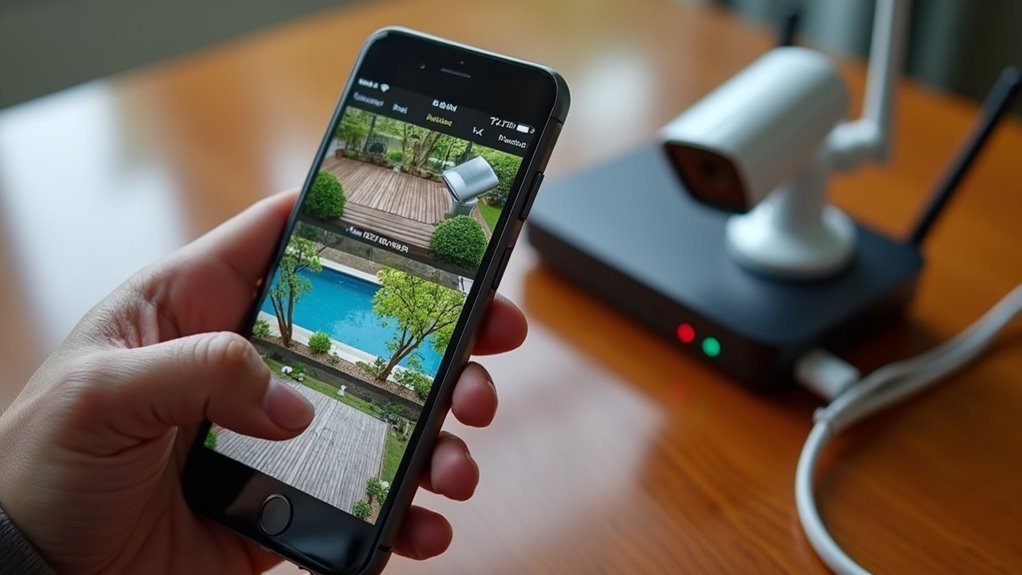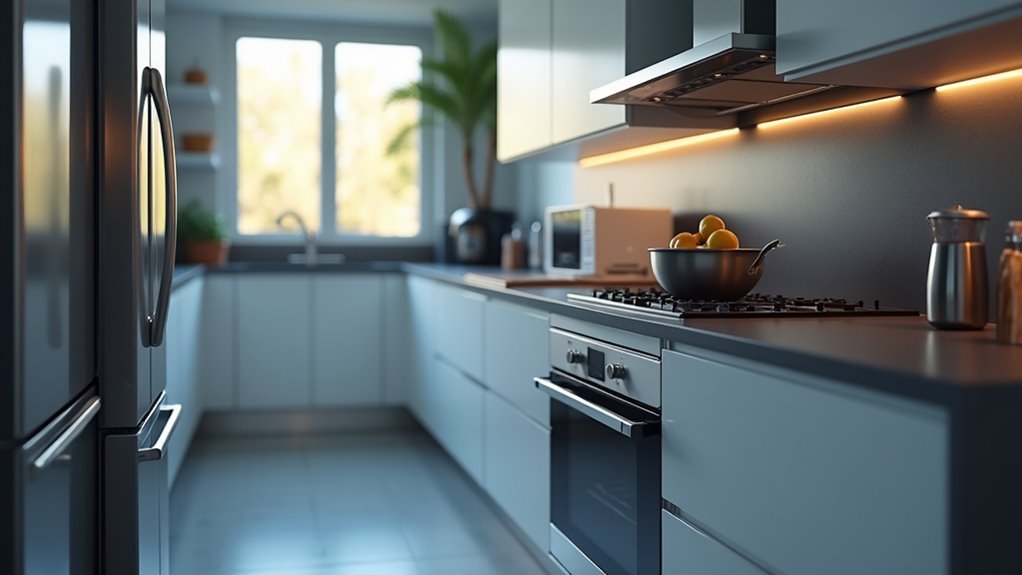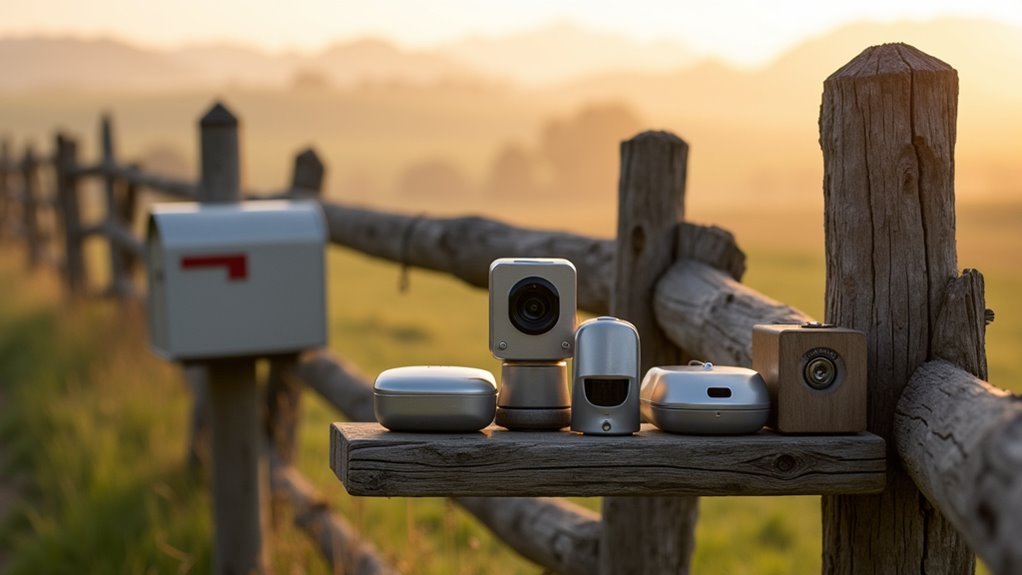You’ve probably noticed your smart home devices scattered across different apps, creating more chaos than convenience. Smart outlets can transform this fragmented experience into a seamless network where everything works together. But there’s a strategic approach that separates homeowners who truly maximize their setup from those who simply add more gadgets. The difference lies in understanding how to create an interconnected ecosystem that anticipates your needs before you even realize them.
Planning Your Smart Outlet Network Throughout the Home

When planning your smart outlet network, you’ll want to start by identifying the high-traffic areas in your home where you use multiple electronic devices daily.
Focus on installing smart outlets in your living room, kitchen, and entryway where you’ll get maximum benefit from centralized control. Consider using smart power strips to connect multiple devices to a single outlet, reducing clutter while expanding your smart home devices capabilities.
Before installation, assess your Wi-Fi network strength throughout these areas. A reliable connection is crucial for consistent performance.
If you’re experiencing weak signals, consider upgrading to a mesh network system. This guarantees all your smart outlets maintain stable connectivity, enabling effective energy usage monitoring and scheduling features that’ll optimize your home’s efficiency.
Selecting Compatible Smart Outlets for Different Room Functions
Why should you settle for generic smart outlets when different rooms demand specialized features?
You’ll need compatible smart outlets that integrate seamlessly with your existing smart home ecosystem, whether that’s Amazon Alexa, Google Home, or Apple HomeKit.
For kitchens and bedrooms, prioritize outlets with multiple USB ports to handle frequent device charging. Choose models with energy monitoring capabilities to track power consumption and identify energy-wasting appliances throughout your home.
Set up automation routines tailored to each room’s function – schedule bedroom lamps for morning wake-ups or kitchen appliances for meal prep times.
Ascertain your selected outlets support voice control and mobile app access, making device management effortless even when you’re away from home or dealing with hard-to-reach locations.
Strategic Placement for Maximum Automation Benefits

Once you’ve selected the right smart outlets for each room, their placement becomes the determining factor in how effectively they’ll automate your daily routines.
You’ll maximize automation benefits by strategically placing smart plugs where they’ll have the greatest impact on your home’s efficiency and convenience.
Focus on high-traffic areas like living rooms and kitchens for frequently used devices.
Install smart outlets in hard-to-reach locations such as attics and garages to improve accessibility.
Connect outdoor lighting systems to enhance security while reducing manual effort.
Use smart plugs with energy-intensive appliances like refrigerators and A/C units for significant energy savings during peak hours.
- Morning coffee maker activating automatically as you wake up
- Outdoor pathway lights illuminating your evening arrival
- Multiple living room devices powering down with one command
- Garage workshop tools controlled from your smartphone
- Kitchen appliances scheduling around utility rate changes
Connecting Multiple Devices to Your Smart Home Hub
Building a thorough smart home network requires connecting multiple devices to your central hub, transforming individual smart outlets into coordinated automation systems.
When integrating your smart outlets, you’ll need to verify compatibility with your chosen ecosystem—whether Amazon Alexa, Google Home, or Apple HomeKit—to guarantee seamless device management.
Connect appliances like lamps, coffee makers, and fans that benefit most from automation. You can control devices remotely while monitoring their energy consumption patterns through your smart home hub’s interface.
Use power strips with smart outlets to manage multiple appliances simultaneously through one plug. Schedule operations at specific times to maximize energy efficiency throughout your home.
Regular monitoring helps identify high-consumption devices, allowing you to make adjustments that improve overall energy management and create a cohesive automated experience.
Creating Coordinated Scenes and Schedules Across Rooms

You’ll transform your smart home experience by programming room-based scenes that coordinate multiple outlets to create perfect ambiance for any occasion.
Setting up multi-room schedule coordination lets you synchronize devices across your entire home, so your morning routine can simultaneously start the coffee maker, turn on bathroom lights, and activate your home office setup.
This level of automation guarantees your connected devices work together seamlessly, whether you’re hosting dinner parties or simply moving through your daily activities.
Room-Based Scene Programming
When you group smart outlets by room, you’ll transform scattered devices into cohesive, coordinated systems that respond to your daily routines with precision.
Room-based scene programming enables you to control multiple smart devices simultaneously, creating seamless experiences throughout your home. You can activate morning routines that gradually brighten lights while starting your coffee maker, or establish bedtime scenes that dim all living room fixtures and turn off entertainment systems automatically.
- Morning sunlight streaming through windows as your bedroom lamps slowly brighten and coffee begins brewing
- Evening ambiance with dimmed dining room lights while the dishwasher quietly starts its cycle
- Motion sensors detecting movement and illuminating hallway pathways during midnight trips
- Voice commands instantly transforming your living room into movie-night mode with coordinated lighting
- Automated energy efficiency schedules turning off forgotten devices across multiple rooms
Multi-Room Schedule Coordination
Smart outlets reach their full potential when you coordinate schedules across multiple rooms, creating a synchronized home ecosystem that responds to your lifestyle patterns.
Use smart home technology apps to establish routines set for different areas simultaneously—bedroom lamps activating at sunset while outdoor lights turn on at dusk. Geofencing triggers coordinated actions based on your location, automatically preparing multiple rooms as you approach home.
Energy efficiency improves dramatically when you schedule high-consumption devices like dishwashers and washing machines during off-peak hours across various house areas.
Voice commands through smart assistants enable seamless orchestration—simply say “Goodnight” to turn off lights in all bedrooms while activating living area security features.
This all-encompassing approach transforms individual smart outlets into a cohesive network that anticipates and responds to your daily rhythms.
Managing Power Loads and Energy Monitoring
You’ll gain unprecedented control over your home’s electrical consumption by strategically distributing power loads across your smart outlets and monitoring energy usage in real-time.
Smart outlets let you track exactly how much power each device consumes, revealing which appliances drain the most electricity and cost you money.
Power Load Distribution
Because electricity consumption varies dramatically throughout your home, smart outlets serve as essential tools for monitoring and managing power loads across different circuits and devices.
These intelligent plugs provide real-time insights into energy consumption patterns, helping you identify which appliances and devices consume the most power. By strategically distributing your power load distribution across multiple circuits, you’ll prevent dangerous overloads while maximizing energy efficiency throughout your home.
Smart outlets enable precise tracking of individual device consumption, empowering you to make data-driven decisions about usage habits and replacement priorities.
- Kitchen appliances humming efficiently on balanced circuits without overloading breakers
- Entertainment systems distributed across separate outlets to prevent power spikes
- Home office equipment monitored individually for peak energy performance
- High-consumption devices scheduled during off-peak hours automatically
- Real-time energy data displayed on your smartphone for instant load awareness
Real-Time Energy Tracking
When monitoring your home’s energy consumption becomes as simple as glancing at your smartphone, smart outlets transform how you understand and control electrical usage throughout your property.
Real-time energy tracking through these devices reveals exactly how much power each connected appliance draws, exposing hidden energy drains you’ve never noticed before.
You’ll receive instant notifications when devices consume excessive power, alerting you to potential malfunctions or inefficiencies.
Historical usage data helps you identify patterns and make informed conservation decisions.
Smart outlets enable you to optimize usage by scheduling devices during off-peak hours when electricity rates drop considerably.
This thorough monitoring approach enhances energy efficiency while reducing monthly utility costs through data-driven automation and strategic power management across your entire home setup.
Peak Usage Optimization
Three strategic approaches define effective peak usage optimization: automated load scheduling, demand response participation, and intelligent power distribution.
Smart plugs enable you to program high-energy devices to automatically shut off during peak usage hours, directly reducing electricity costs and avoiding expensive demand charges. You’ll maximize savings by creating automated schedules that align with utility demand response programs, earning rewards for reducing energy consumption when grid demand peaks.
Energy monitoring through smart outlets reveals which appliances consume the most power, allowing you to make informed decisions about usage patterns. This data-driven approach helps you optimize energy consumption and achieve better load balancing across your home’s electrical system.
- Morning coffee maker automatically brewing before peak hours begin
- Air conditioning units cycling off during afternoon demand spikes
- Electric vehicle charging shifting to overnight low-rate periods
- Pool pumps running during mid-day solar generation peaks
- Washing machines starting cycles during off-peak evening hours
Troubleshooting Multi-Device Connectivity Issues
Why do multiple smart devices suddenly stop responding when connected through your smart outlet? Most smart plug connectivity issues stem from Wi-Fi frequency mismatches, as these devices typically operate on 2.4GHz networks.
When multiple devices compete for bandwidth, connections become unstable.
Start troubleshooting by restarting your router and smart devices to reset network connections. Check your manufacturer’s app for firmware updates, as outdated software creates compatibility problems.
If you’re experiencing dropped connections, reduce the number of devices connected to one outlet or upgrade to a smart plug with higher power ratings.
Monitor your Wi-Fi signal strength near outlet locations regularly. Weak signals considerably impact performance when managing multiple devices.
Consider repositioning your router or installing a Wi-Fi extender to improve coverage throughout your home.
Frequently Asked Questions
What Should You Not Plug Into a Smart Plug?
You shouldn’t plug high-wattage appliances, medical devices, refrigerators, or appliances with built-in timers into smart plugs. Don’t use them with surge protectors either, as they’ll create safety hazards and operational problems.
How to Set up Multiple Smart Plugs?
You’ll need to download each smart plug’s app, connect them to your 2.4GHz Wi-Fi network, then create automation routines linking multiple devices for coordinated control and scheduling.
Is There a Limit to How Many Smart Plugs You Can Have?
You can typically connect up to 100 smart plugs per hub, but your Wi-Fi bandwidth and router capabilities will determine the practical limit before you experience network slowdowns.
What Device Allows You to Connect Multiple Devices to a Single Outlet?
You’ll want a smart power strip to connect multiple devices to one outlet. It provides individual outlet control, surge protection, and often includes USB ports for charging while integrating with voice assistants.





Leave a Reply